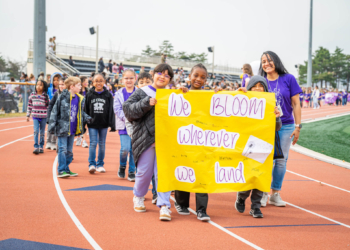Virtual, in-person, or hybrid – how to decide what is best for your child and their learning this fall.
When Travis Elementary gave students the option to learn in person again in March 2021, Evangeline Love, an extroverted, energetic, only child in second grade, immediately knew what she wanted to do — return to her school.
Her mother, Ashley Love, said no.
Love, the wife of an active-duty Air Force officer, earned two doctorate degrees and two master’s degrees in health-related fields and is an associate professor at the Dreeben School of Education at the University of the Incarnate Word in San Antonio, Texas. She served as Delaware’s state epidemiologist and managed all of the epidemiologists during the 2009 H1N1 pandemic.
As a parent and health professional, she worried due to the lack of a COVID vaccination for their daughter’s age group (younger than 12 years old) and new variants of the virus, despite statistics that show that she is at the lowest risk for hospitalization and death compared to other age groups. Plus, the family had established a routine that accommodated the parents’ work schedules and Evangeline’s virtual-only learning. All was going well, given the circumstances.

Yet, at the last minute, she changed her mind, allowing her daughter to go back to school for four hours, two days a week after spring break. Driving their flip-flop? Evangeline’s mental well-being.
“We were so torn,” shared Love. “She wanted to interact with kids in her own age group. Virtual meet-ups were not enough for the past year.”
Having a good relationship and strong communication with Travis Elementary School, which Evangeline had entered as a kindergartener, allowed the couple to make the hard decision, Love said.
Read: Educational considerations for parents considering home school.
Love suggests that parents should ask what, how, and why choices were made. They should check to see if the school is following Centers for Disease Control and Prevention guidelines to include the following groups in their decision-making process:
- Administrators
- Teachers
- Student and parent representatives
- Specialized instructional support personnel (school counselors, school social workers, school psychologists, and nurses)
- Facilities managers and custodial staff
- Transportation personnel, school nutrition professionals, and family services representatives
Parents still unsure after collecting initial information can ask for a tour.
“Are you satisfied with the answers about safety matters?” Phil Ollenberg, assistant registrar at Bow Valley College in Alberta, Canada, advises parents ask themselves after a tour. “Do the practices you’re seeing with your own eyes make you confident for your child’s safety?”
Consult www.cdc.gov/coronavirus/2019-ncov/community/schools-childcare/operation-strategy.html for the CDC’s updated suggestions. Similar international sources are available for military families stationed outside the country. Love also recommends taking the needs and feelings of your child into consideration. Everyone is different.
“As a mother, I say ‘yes’ to making your child’s wishes a key factor in the decision-making process,” said Love. “I know some of my colleagues kept their kids at home because the kids were fine online. On the other hand, my daughter thrives in settings where there are people and interaction in person.”
Love reports that social butterfly Evangeline flourished in the spring with hybrid instruction and loved learning this way.
“She is happier,” Love added, “and feels like she is part of the community.”
This fall, the rising third grader plans to be back in the classroom full time.
Look for part two of our back-to-school coverage coming up in the August issue. Our next article will discuss what to look out for when your child is transitioning to the new school year to ensure he or she is thriving.
Back to school plan for learning
For parents still seesawing about school this fall, here are some tips for creating a plan of action:
- Search the school’s website for details on safety protocols.
- Check emails and social media posts, especially ones made by parent-teacher association leaders or other individuals who are often motivated to gather the latest information.
- Go directly to the source — call the school.
Students from preschool to college can experience thousands of variations on common virus-related policies, such as:
- Vaccination requirements
- Mandatory COVID symptom screenings and testing
- Mask-wearing protocols
- Desk partitions
- Social distancing
- Extensive cleaning procedures
- Air filtration systems
- Reduced number of activities and events
And possibly, no restrictions at all. Laws and guidelines on the federal, state, and school district levels change frequently. Make it a priority to keep up to date on changing policies.













































